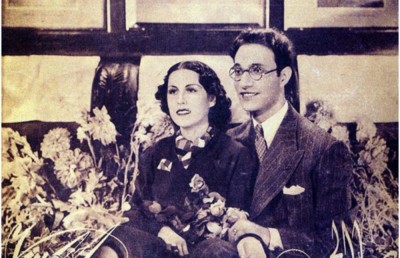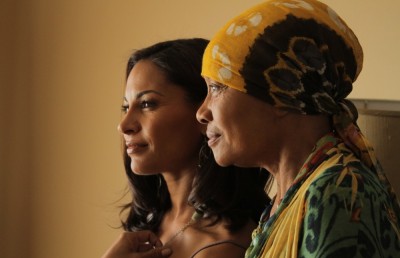Cinematic Representations of Anna Walentynowicz: Documentary, Fiction, Feminism, and the Polish Solidarity Movement
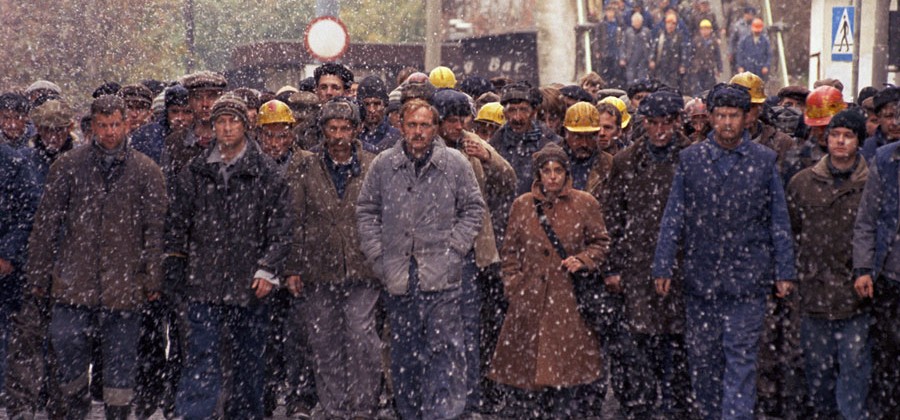
When Anna Walentynowicz died in the well-publicized plane crash that took the lives of the president of Poland and other dignitaries on April 10, 2010, few people outside of Poland would have recognized her name. Yet when the history of the late 20th century is written, Walentynowicz may emerge as one of the most significant women of her time. As students of history like Shana Penn and Timothy Garton Ash have reexamined the Polish Solidarity workers’ union of the early 1980s, there has been rising interest in the role of women in the movement. Whereas Lech Walesa previously received most of the attention, Walentynowicz at the time of her death had begun to emerge from the shadows of memory. Three films about Walentynowicz display three different representations of this major figure. Two of them, Slawomir Grünberg’s Anna Proletarian (1981), made with Marek Ciecierski, and Jill Godmilow’s Far From Poland (1984), are nominally documentaries from the time of the uprising, and both experiment with formal structures and intentional discontinuities. The third, Strajk (2006) by Volker Schlöndorff, uses a more conventional docudrama form and reflects on events from the hindsight of history. This trio of films creates a collective portrait of a woman who emerged from the working class to become a leader and a catalyst for historic change. (See illustration 1.) Each of the three films undermines simplistic Capital vs. Labor stereotypes. They make the communist bureaucracy the antagonist in narratives that celebrate the worker even while they examine the contradictions inherent in the strikers’ rebellion.
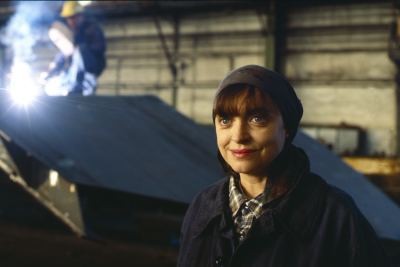
Katharina Thalbach portrays Anna Walentynowicz —renamed as ‘Agnieska Kowalska’ for legal purposes —in Volker Schlöndorff’s Strajk. (Photo: Volker Schlöndorff.)
This essay deals with three films that present a woman, Anna Walentynowicz, as a major player of the Solidarnosz movement and thereby revises the image of its revolution. It offers a comparison and contrast of the three films to illuminate the filmmakers’ diverging strategies about gender, genre and structure. It also highlights elements of each of the films’ production history and traditions. It suggests, finally, that the three filmic texts, taken together, result in more than the sum of their parts.
Anna Proletarian, Far From Poland, and Strajk use differing but equally inventive styles and approaches. Their subject matter is rich precisely because it does not conform to good-vs-evil stereotypes, and because it requires reassessment of the political battle lines drawn by previous generations. They examine an ordinary woman’s role in political change and each embodies and reflects on the optimism that drives activist resistance to oppression.
The Solidarity movement and its reception worldwide are both replete with contradiction. Protesting against communist bureaucracy and oppression, Solidarity was organized by workers against a state that was supposedly founded to represent workers against Capital. In contrast to anti-religious communism, the workers of Solidarity took inspiration from Pope John Paul II. In the United States, the movement could be supported by both the radical Left and by Ronald Reagan, because each side could claim kinship to the workers’ struggle. Timothy Garton Ash emphasizes the aspects that appealed to both: Solidarity’s fighting for the values of “individual freedom, democratic government, the rule of law,” the movement was “an extension of the American revolution by other means.” The political right, specifically the Reagan administration, was, however, uncomfortable with the way the movement favored the welfare state, opposed privatization of heavy industry, and sought to give workers control of the workplace. 1
Recognizing Walentynowicz’s role has clear feminist implications. A woman like Anna Walentynowicz was able to enter into a male-dominated workplace and to become a welder because of the very socialist ideology she was later to oppose. She was able to use the leadership skills she acquired to undermine the system that gave her that opportunity in the first place. (See illustration 2.) Other portrayals of Solidarity, in both print and on film, have tended to downplay both Walentynowicz and the role of women. Adrezej Wajda’s Man of Iron (1981), for example, the highly circulated semidocumentary film about the events at the Lenin Shipyards, puts women in only secondary roles, although it includes cameo appearances by both Walesa and Walentynowicz.
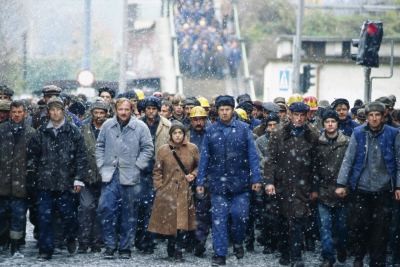
Strajk presents Walentynowicz as a woman who holds her own in a sea of men. (Photo: Volker Schlöndorff.)
None of the three films discussed here presents itself as overtly feminist, but all three celebrate a woman whose militancy and tenacity led to the successful workers’ uprising that eventually resulted in the downfall of communism. The two documentaries blend this implicit feminism with the tradition of the non-fiction film about worker protest, one that extends from Joris Ivens and Henri Storck’s Borinage (1933) to Barbara Kopple’s Harlan County U.S.A. _ (1976). Indeed, Grünberg’s _Anna Proletarian is an early work by a documentarist who has since won multiple awards for socially relevant nonfiction television work in the United States. His oeuvre includes the 2002 Fenceline, a documentary showing community resistance by African Americans to the Shell Oil Company over environmental concerns. 2 Indeed, it was the screening of Anna Proletarian_ at New York’s Museum of Modern Art that led to Grünberg’s emigration to America and subsequent success. 3 For her part, Godmilow shot to fame when she won the Academy Award for Antonia (1974), a documentary about Antonia Brico, who had struggled against sexism to have a career as a symphony conductor at a time when such achievements were unusual for women. 4 Although Godmilow includes in Far From Poland staged interviews with two men, one a communist era censor, the other a mineworker, neither of the other two are as vivid as the interview with Walentynowicz. Perhaps for a Western audience, the female status of the oppressed victim makes Walentynowicz more resonant or more sympathetic. One might compare Walentynowicz’s story of the morning she was fired from the shipyards with Wajda’s portrayal of the fictional figure Maciej in Man of Iron_.
In both cases, the administrative worker presenting the “pink slip” says that she had to take two tranquilizers before coming into work that day, and declares that if she refused to do the firing and lost her job, management would hire someone else to do the same thing. In both films, the reply of the fired worker is the same, i.e., that if all workers stood together, there would be no one to do the firing: “They can’t fire everyone.” Wajda’s almost verbatim lifting of an incident from the real life of a woman worker and giving it to a man perhaps suggests his questionable shifting of the labor struggle onto a predominantly male battlefield.
The Schlöndorff film extends the director’s preoccupation with presenting assertive, rebellious women, as seen in movies like The Lost Honor of Katharina Blum (1975), Coup de grace (1976), The Handmaid’s Tale (1990) and The Legend of Rita (2000). All three moviemakers come out of traditions of politically engaged filmmaking.
Grünberg’s Anna Proletarian begins as a conventional documentary portrait of Walentynowicz. (See illustration 3.) As the half-hour movie progresses, however, it introduces material about earlier parts of the activist’s life. We see footage from previous worker uprisings and hear about Walentynowicz’s response to them. We learn of the death of her husband and her subsequent mourning. We hear of her attending a workers’ convention in the Berlin of the 1950s and her describing the pride she felt when she got a job at the Gdansk shipyards. The movie ends with imagery from her optimistic years when she believed in the communist ideal, even while she offered thanks to God for her good fortune. The result is a reverse chronology: Grünberg has said that he chose that ordering to present the viewer with the contradictory final surprise of how committed to communism the young woman was when she started her job. 5

In Anna Proletarian, Walentynowicz revisits the places of her mistreatment by authorities. (Photo: Slawomir Grünberg.)
Only part of Far From Poland deals with Anna Walentynowicz, yet it is doubtless the most significant and memorable part of the movie. After raising the money to make a film about the Solidarity movement, director Godmilow was unable to obtain visas to bring her and her crew to Poland. Having read a provocative interview with Walentynowicz, Godmilow chose to restage the interview using the actress Ruth Maleczech playing Walentynowicz. 6 (See illustration 4.) The consequence is a theatrical performance of Walentynowicz’s words, which Godmilow then intercuts with other materials and commentary. Textbooks and historical surveys about documentary film have used Far From Poland as an extreme case example of the sometime fuzzy borderline between cinematic fiction and nonfiction and an example of the “reflexive” or “deconstructionist” documentary. 7
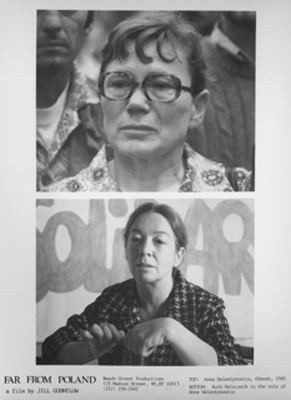
The real Anna Walentynowicz (top) and her enactment by the actress Ruth Maleczech (bottom) in Far from Poland. (Photo: Jill Godmilow.)
By contrast, Schlöndorff subtitled Strajk “a ballad based on historical events.” Even if Schlöndorff’s is structurally the most conventional film and the one most grounded in traditional storytelling, the German filmmaker claims he wanted to avoid the conventions of the traditional biopic, preferring to explore a more open-ended narrative structure, “a basket into which I threw everything.” 8 Because Walentynowicz was opposed to the project, Schlöndorff changed the name of the heroine to Agnieszka Kowalska. In the last half hour of the movie, Schlöndorff moves some of the narrative emphasis off of Agnieszka and onto the collective movement in general, “to show how she affected world history without even knowing it.” [[Sonja M. Schultz, “Strajk — Die Heldin von Danzig.” critic.de. Agnieszka Kowalska becomes one player in a team of many.
One can compare and contrast the three films to reveal how historical contradictions of the Solidarity movement steered each of the three filmmakers to adopt different strategies for the endings of their films. Each of the three modes of filmmaking throws a different kind of light on the same subject matter and in comparison and contrast with one another, they offer a provocative study in how the contradictions of the Solidarity movement become expressed.
In each case, the filmmaker’s strategy to interpret history becomes clear through the formal qualities of the films themselves, for instance through the choice of an ending. Grünberg’s achronological structure suggests that in 1981, there was no way to know where the movement was going. Rather, one can only go back to where it began and see how the idealism of immediate post-war Stalinism mutated into the idealism of Solidarity. Grünberg presents a progression that runs the same way both backwards and forward, from optimism to disillusionment to optimism again. The abrupt conclusion startles, and signals the ending of the film as the beginning of the story, a story not yet finished.
Later, in her interview included on the DVD 9 , Godmilow talks about the challenge that she had in finding a conclusion to Far From Poland. By the time she was completing her film, Poland had been returned to martial law and the Solidarity movement seemed a failure. Not wanting to make a film about a failed revolution, Godmilow concluded Far From Poland with a fantasy sequence set in a future 1988 – General Jaruselsky has been deposed and is writing letters to his daughter from a country villa where he has been imprisoned. The fantasy sequence proved to be remarkably prescient when the world in 1989 witnessed the collapse of communism in Eastern Europe.
Godmilow’s message is that the immediate success or failure of social activism is less important than the process of sustaining the struggle. The historical context is the precipitous decline of the American labor movement by the end of the 1970s, one that has been documented in books such as Jefferson Cowie’s Staying Alive (2009). For a self-described leftist filmmaker like Godmilow, the news from abroad of workers’ empowerment clearly acted as a stimulant. The restaged interview with Walentynowicz becomes less the reporting of an event than a source of wonder. Popular critic Roger Ebert has complained about the artificiality of the restaging: “The words come forth too fluently, too smoothly, so that they sound like a text that has been memorized, rather than a real person groping for expression in an unfamiliar language.” [[Roger Ebert, “Far from Poland.” Chicago Sun-Times (2 February 1985), But clearly this is not intended as a realistic restaging. Maleczech’s performance, specifically her style of speech, has little to do with the conversational style of the woman welder and crane operator Walentynowicz.
The interview’s words are treated almost like poetry recited in a slow deliberate manner, or, as Godmilow’s DVD interview suggests, as “readers’ theater.” Because of this stylistic emphasis, the viewer should find it impossible to take the interview as just another talking head in routine television reporting.
What is more, Godmilow fragments and interrupts the interview. In some cases a voice-of-God-narrator will explain or contextualize a remark that Walentynowicz has just made. At other times, Godmilow cuts to discussion by Polish expatriates who analyze the social situation. Godmilow thus goes from the specific and vivid, described in the interview, to the general and conceptual. We see former Polish student rebels, one of whom now teaches at Yale, discuss how communism created mediocre leadership and how Solidarity’s non-ideological stance allowed Poles of different political persuasions to unite under principles of workers’ rights and freedom of expression. These commentators are seen not directly but rather on TV monitors, creating a further level of removal from an original recording. For Godmilow, social activism involves constant questioning and analysis. There is too much material for a neat, concise narrative.
Schlöndorff’s ending shows Agnieszka Kowalska, his Anna Walentynowicz, walking on the beach years later, while a narrator’s voice-over comments that the shipyards are now closed, the result of globalization and the free-market economy. Schlöndorff thus replaces a conventional happy-ending narrative with an alternative that shows how the successes of Solidarity may have only added to further contradiction. The filmmaker confirms his intention to produce echoes of the comparable misery of workers in the first decade of the 20th century:
And, of course, what moves us today enters into the film — mass firings, unemployment, below subsistence wages. Something as old-fashioned as a strike at once has a different ring, when you know that the wharf will be liquidated exactly as so many workplaces are being liquidated with us in Germany, and that not too long ago people there fought for fundamental freedoms. 10 This ending turns what has preceded it into a nostalgic mourning for a world in which the rights of workers who controlled their own destiny should be seen as an unambiguous goal. Making Strajk in 2006, at a time when the German labor movement felt the same pinch from globalization as its counterparts elsewhere, Schlöndorff looks back at a time when achieving the goal of workers’ power might have seemed a reasonable possibility. Characterized as a leftist director in the 1970s, Schlöndorff has in recent years moved to the political center, as in his initial support of German chancellor Angela Merkel. 11 Strajk, however, confirms his fundamental support for the principle of a strong, dignified labor force as a foundation for society.
Schlöndorff stylistically suggests that the Solidarity movement may in its own way have been fulfilling the original Soviet era’s goals. There is a sequence fairly early in the film during the period in which Agnieszka is learning to read so that she can pass the crane operator test. As she learns to read the posters and signs around her, Schlöndorff pays homage to the graphic design styles of the Soviet era. He shoots the sequence with montage-style editing, thereby citing the practices of the Soviet filmmakers of the 1920s. Schlöndorff accepts the Soviet aesthetic, and thus perhaps its ideals, even while he critiques the failure of its eventual governing practices.
In calling his film a ballad, Schlöndorff acknowledges a tendency to oversimplification and myth-making. What Schlöndorff adds to Strajk, which sets it apart from documentary or even docudrama, is a whole metaphoric level. One dramatic line of Strajk involves Agnieszka’s factory supervisor being the father of her child. This plot configuration becomes a metaphor for the seduction and abandonment of Poland by its overpowering neighbor, the Soviet Union. Schlöndorff inscribes a political trope onto this archetypal narrative convention of the exploited single mother. Agnieszka turns into a metonym for Poland itself, struggling to be on its own after having been exploited. Could a Pole making this film have fashioned a similar bold metaphor? Wajda, Poland’s most prominent filmmaker, has observed that Strajk could only have been made by a foreigner because any Polish filmmaker would have become mired in the political infighting that followed in post-communist Poland. [[Andrzej Wajda. “Wenn der Wodka floss, warum das nicht zeigen?” Interview by Gerhard Gnauc. Welt online, 1. März 2007. 1-4, p. 2 of 4
Stylistically all three Walentynowicz films share the subdued greyness that does in no way beautify or aestheticize the world presented. Bill Nichols has referred to the documentary form as embodying what he calls “discourses of sobriety.” 12 All three films avoid the visual pleasures of pretty colors, beautiful performers, and exotic locations. Schlöndorff shot Strajk on location at the Gdansk shipyards, and there is nothing glamorous about that choice. Agnieszka becomes a motherly figure rather than the object of male gaze. She is an anti-Ninotchka—an assertive and forceful woman who rejects communism without ever being trapped into superficial femininity. In its comparable abandonment of eye candy, Godmilow’s rephotographing of many of her images from television monitors deliberately undermines any photographic beauty they might otherwise embody. Indeed, Lauren Rabinowitz has compared Far From Poland to Claude Lanzmann’s Shoah (1985), commenting, “Each suggests that the rhetoric of postmodern documentary has shifted film form away from visuals: they produce a cinema of the word as much as of the look. 13
Like Godmilow, Schlöndorff presents the Solidarity uprising as an event that the world outside Gdansk has experienced through the medium of television. A major leitmotif in Strajk is the presence of a TV set. Early in the film Agnieszka is awarded a TV set for her high productivity but she returns the device in protest. After she successfully negotiates widows’ benefits for the spouses of workers killed on the job, the women involved pitch in to buy her a new set, which she keeps. Periodically in the remainder of the film, we see events, such as Pope John Paul’s visit to Poland, through the intervening medium of television. Near the end of the film, when Agnieszka awakes in front of her TV as her son hugs her, she is no longer merely an observer. She has become an object of the country’s admiration, an idea implicitly reinforced by Schlöndorff’s staging. In these shots, the eyes of his actress, Katharina Thalbach, are turned not toward the TV screen but toward us, the audience. Implicit in this is the notion that modern media played a major role in the success of the Solidarity movement. Both Schlöndorff and Godmilow delight in this sense of a created global village. The revolution, they suggest, is joyfully experienced both through real people and through their images.
A repeated theme in both Strajk and Far From Poland is the social activist’s need for optimism. On a theoretical level, it is possible to associate this feeling of optimism with the idea of narrative. Optimism creates narrative teleology. If we believe that good will triumph over evil, we construct narrative in which that will happen. One cannot help but be struck by the statistic Ash reports that the suicide rate in the country dropped by almost a third between 1980 and 1981. 14 Godmilow, refusing to accept the apparent failure of Solidarity in the early 1980s, creates a “false” optimistic narrative conclusion. In Strajk, the heroine’s belief in her cause parallels her belief in Catholicism. Schlöndorff adds a sub-plot in which Agnieszka is diagnosed with kidney cancer, only to find that the cancer miraculously disappears five years later. Agnieszka comes to believe that God has destined her for something, but she does not yet know what it is. By contrast, we associate narrative disjunction not with belief in destiny but with self-doubt, with hesitation, and with contradiction.
All three films present a tension between faith, religious or secular, and uncertainty. Throughout Far From Poland, Jill Godmilow expresses her uncertainties and misgivings about creating a film about Poland without being able to return there. Parallel to these are similar doubts about whether her support for Solidarity conforms to her leftist principles. The interview with Walentynowicz becomes a kind of declaration of faith, which the director periodically interrupts to provide additional supporting testimony. It would be easy to see Godmilow’s tactics as mere imitations of the Brechtian theatre or the Godardian cinema. Godmilow would acknowledge these influences. But her tactics coherently respond to the nuances and confusion inherent in the subject matter.
In contrast to Godmilow’s anxiety and insecurity, we see in the portrayals of Anna Walentynowicz an overriding confidence and self-certainty. Walentynowicz brings to mind social philosopher Eric Hoffer’s notion of the “true believer.” 15 Walentynowicz’s early intense commitment to both the ideal of the socialist worker and to belief in the Catholic church (See illustration 5.) suggests that she applied the same intensity to the Solidarity movement that she had applied earlier to achieve, for example, a scoring of 270% of her quota after the first year on her job as a welder. 16
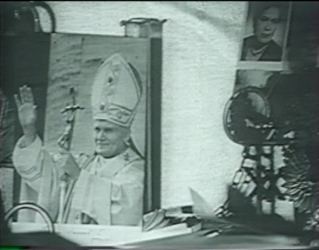
A shot from Anna Proletarian of Walentynowicz’s mantel, with a picture of the Pope prominently displayed. (Photo: Slawomir Grünberg.)
The Walentynowicz of the three films appears as a woman of almost super-human intensity and commitment, but what is less clear is her ability to abandon previous ideals. At the end of Far From Poland, Godmilow addresses the audience directly and runs through a list of things that her movie did not get to deal with. These items include such topics as the role of the Catholic Church in the movement, the effect on Poland of economic forces from outside, and the possible involvement of the CIA. None of the films deal with what may be the crowning irony about Walentynowicz’s life: in Timothy Garton Ash’s analysis, he describes how in her later years Walentynowicz was convinced that Walesa had been an agent of the secret police and that the result of Solidarity was to create conditions even worse than under communism. 17 Other observers have noted that in contrast to many Polish feminists she had become a fervent anti-abortion supporter. 18 Politically, the champion of workers’ rights had moved across the spectrum to the conservative, national-Catholic orientation of the “Prawo i Sprawiedliwość”, or “PiS,” the Law and Justice party. Its leader, the late president Lech Kaczyński, honored her by asking her to accompany him on his fateful flight to Smolensk. Her name is engraved on the memorial to the President in the Marien Cathedral in Gdansk. Schlöndorff, with the benefit of hindsight, is the only one of the three filmmakers who has deliberately elided Walentynowicz’s recent history. To enact Walentynowicz’s subsequent alliances with the political right wing would spoil the direct narrative arc of Schlöndorff’s celebratory ballad.
It would be simplistic to give priority to Schlöndorff’s narrative coherence solely because it becomes dramatically engaging. It would be equally simplistic to privilege Godmilow’s modernism solely because it is complicated and counter-intuitive. And for all its authenticity, to prefer Anna Proletarian solely because it had access to the real Anna Walentynowicz would be equally naïve. (One may note in passing that Grünberg acted as a go-between between Walentynowicz and Schlöndorff’s producers when she was raising legal objections to the latter’s production. 19 )
These three films enrich one another through the discourse created among their varied signifying practices. The enrichment they provide to one another points to the need for what we might call a prescriptive or hortatory intertextuality. The three texts, taken together, become more than the sum of their parts. They show in their way that although we may need narrative to make history meaningful, we proceed at our own risk if we try to reduce history to linear narrative. On a rhetorical level, all three works celebrate the potential for women’s activism and the potential for social change. Each, however, also finds poetic force, be it through the scrambling of chronology, the juxtaposition of diverse modes of expression, or the use of metaphor and leitmotif in creating a quasi-mythic narrative.
Notes
- Timothy Garton Ash, The Polish Revolution: Solidarity. Third Edition (New Haven: Yale University Press, 2002), 327-328. ↩
- See ↩
- Slawomir Grünberg, e-mail to the authors, 20 June 2011 ↩
- Jill Godmilow, “Antonia,” in Alan Rosenthal, The Documentary Conscience: A Casebook in Film Making” (Berkeley: University of California Press, 1980), 359-371 ↩
- Grünberg, Op cit. ↩
- For a printed version of this interview, consult Hanna Krall, “Perhaps People Aren’t Bad After All,” in Andrezej Tymowski, editor, The Strike in Gdansk, August 14-31, 1980 (New Haven: D.H. Back Press, 1981) ↩
- Nichols, Introduction to Documentary (Indianapolis: Indiana UP, 2001) 76-78, 125-127; Lauren Rabinowitz, They Must Be Represented: The Politics of Documentary (London: Verso, 1994); Louise Spence and Vinicius Navarro, Crafting Truth: Documentary Form and Meaning (New Brunswick: Rutgers University Press, 2011), 216-219 ↩
- “Begegnung mit einer Fußnote,” Interview mit Sylke Rene Meyer, Strajk — Die Heldin von Danzig, eds. Jürgen Haase and Wilhelm-Fraenger-Institut Berlin (Berlin, Braunschweig-Druck, n.d.2007), 15 ↩
- “On-camera Introduction by the Director.“Far from Poland (Chicago: Facets Video, 2007) ↩
- Volker Schlöndorff, “Interview,” mit Kirsten Liese. 21 Feb. 2007. ↩
- Volker Schlöndorff, “Volker Schlöndorff erklärt, wen er nicht wählt,“ Die Welt (16 September 2009), online here ↩
- Bill Nichols, Representing Reality (Indianapolis: Indiana University Press, 1991), 3-5 ↩
- Lauren Rabinowitz, Op cit. 194 ↩
- Timothy Garton Ash, Op cit., 294 ↩
- Eric Hoffer, The True Believer: Thoughts on the Nature of Mass Movements (New York: Harper, 1951 ↩
- Shana Penn, Solidarity’s Secret: The Women Who Defeated Communism in Poland (Ann Arbor: U. of Michigan Press, 2005), 38 ↩
- Timothy Garton Ash, Op cit., 378-379 ↩
- Shana Penn, Op cit, 30 ↩
- Slawomir Grünberg, Op cit. ↩


_400_258_90_s_c1.jpg)
_400_258_90_s_c1.jpg)
